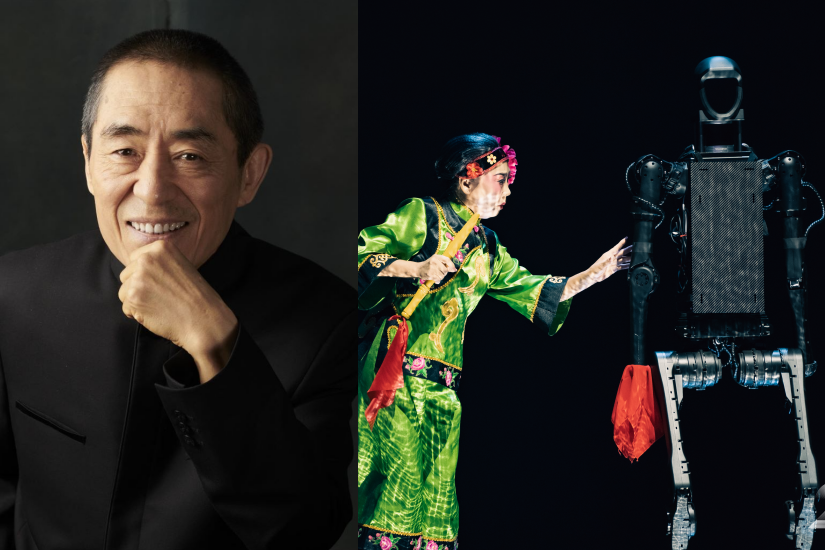When it comes to intangible cultural heritage (also known as intangible cultural assets or property, abbreviated as ICH), it often feels difficult to approach. But what about the fusion of ICH with AI? Whether you’re an art enthusiast or a tech lover, the residency show “Macau 2049,” co-created by MGM and Chinese director Zhang Yimou, is sure to expand your horizons!
This marks the culmination of a 7-year partnership between Zhang Yimou and MGM, which finally took center stage last December at the MGM Theatre! Together, they have broken the boundaries of traditional theater to create a timeless technological art performance on a new stage in Macau—featuring everything from the melodious Miao songs to energetic lion dances. Through music, dance, and various technological elements, eight intangible cultural heritage items of China are presented in a whole new way, offering the audience a unique visual and auditory experience.
This work not only celebrates the 25th anniversary of Macau’s return, but also marks Zhang Yimou’s first directorial masterpiece in the Greater Bay Area and his inaugural residency performance. Directed by Zhang Yimou, it features numerous masters and renowned teams from various fields, including crossover musician Wu Tong, internationally acclaimed choreographer Sang Jiagao, famous sound engineer Jin Shaogang, lighting master Ren Dongsheng, stage visual director Dominic Faraway, underwater photography director Bernard Prentice, and 20 other world-class teams, forming a behind-the-scenes crew of 582 members, comparable to that of a Hollywood blockbuster. This unprecedented production involved 237 days of preparation and 2,838 hours of meticulous refinement, set to redefine everyone’s perception of intangible cultural heritage and stage arts.
Director Zhang Yimou stated that this is a moment that bridges the past and the future, allowing us to find a resonance between ancient civilization and future technology. What are the highlights of “Macau 2049” that you can’t miss? Let’s take a look!
1. Intangible Cultural Heritage of China X Technology Spotlight:《Divine Drum · Shadow》
Folk Song Flowers X Remote-Controlled Programmable Mechanical Arm
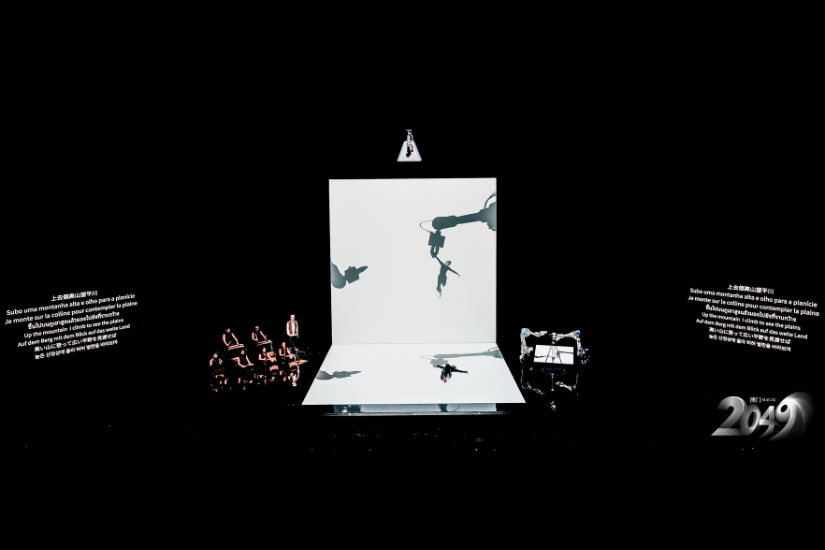
The folk song “Flowers” (commonly known as Wild Tune or Youth) originated in the early Ming Dynasty and is widely circulated among various ethnic groups such as Hui, Han, Tu, Dongxiang, Bao’an, Salar, Tibetan, and Yugur in the provinces of Qinghai, Gansu, Ningxia, and Xinjiang in China. It is named for its lyrics that metaphorically compare women to flowers. The music of “Flowers” is uplifting, long, and bright, featuring colorful musical imagery and rich literary content, and it is often referred to as the “Soul of Northwest China.”
A total of seven instruments were used in the performance, including a large drum, a small drum, a small gong, cymbals, a tambourine, a gong, and a wood block. These were paired with the IRB 2600 robotic arm developed by ABB, capable of 360-degree rotation and bending along the x, y, and z axes, allowing for a series of agile and fast movements. It is also equipped with intelligent sensors that can scan objects and perform tasks with millimeter-level precision through dynamic adjustments, interacting with the performers on stage and creating a very entertaining visual.
2. Cultural Heritage Meets Technology: “Khoomei · Ethereal”
Mongolian Singing Art (Khoomei) X Aerodynamic Flying Silk
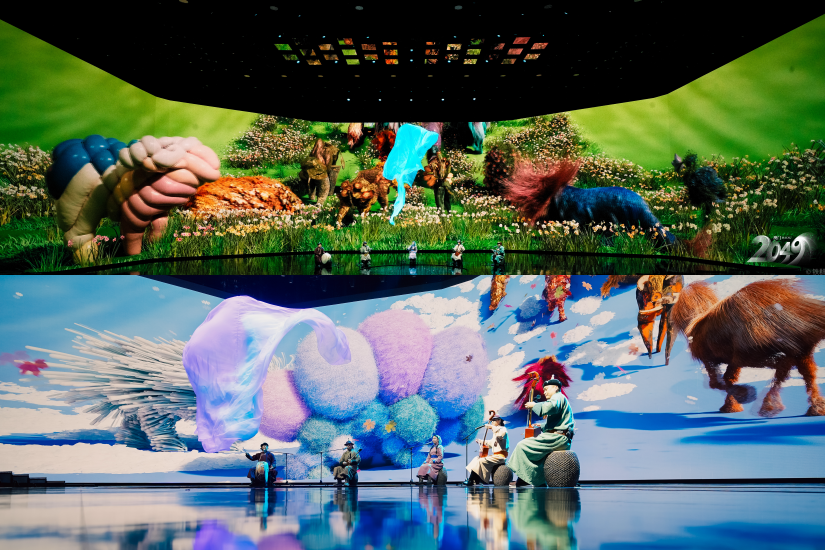
Khoomei is a magical singing art created by the Mongolian people and serves as a means for the ancestors of the Mongolian Plateau to communicate with nature and all living things. The singer solely uses their vocal organs to produce two vocal parts simultaneously: one is the fundamental tone (usually a deep, sustained sound), and the other is high-frequency harmonics or overtones, often applied in grand ceremonies or family festival celebrations.
Under the enchanting sound of throat singing, sixteen fans within the air-powered fabric device generate a central upward thrust with an airflow of 3,200 cubic meters per minute, reminiscent of the funnel-shaped updrafts created by tornadoes. This keeps the fabric’s fluttering range contained within an invisible hollow tubular cyclone above the circular base. The winds within the vortex, completely random and incredibly natural, continuously alter the shape of the fabric, creating a fountain-like visual effect that allows the ethereal fabric to dance gracefully on stage.
3. Chinese Intangible Cultural Heritage X Technology Focus: “Miao Songs · Ethereal”
Miao Ethnic Song and Dance X Dynamic Mirror Light Programming
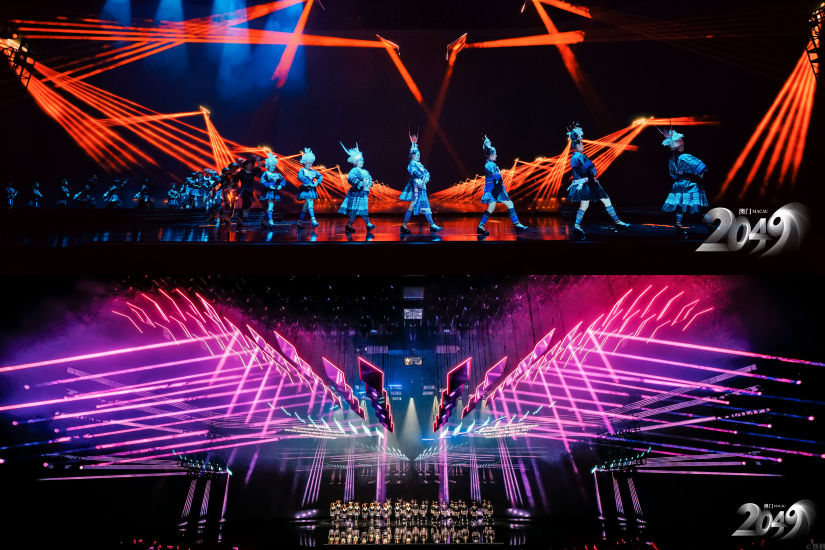
The Miao people are known for their singing and dancing. Due to the absence of a written language in their system, they often express emotions and ideas through song, resulting in generations of traditional Miao songs. The selected performances of “Soul of the Rice Flower,” “Song of Spring,” and “Love Song” are classic repertoires of Miao music, characterized by distinct rhythms, dynamic energy, and powerful resonance that are highly infectious. The embroidery and silver adornments of their traditional costumes also carry rich meanings and intricate beauty, often hailed as “history books worn on the body.”
Equipped with a dynamic mirror installation made up of 108 power mirrors and 72 laser lights, each mirror is fitted with motion sensors that can sensitively capture changes in the environment, adjusting the rotation and position of the mirrors in real-time. This creates reflections at various angles and light intensities, easily presenting vibrant and rich colors, with light beams capable of penetrating several kilometers. Notably, the WHITEVoid team has programmed to integrate kinetics with the optical system, so that as the matrix of mirrors shifts and rotates, 72 beams of varying intensity, color, and texture are precisely reflected on the mirrors, constructing a kaleidoscopic and infinitely expansive geometric structure. This extends the viewer’s gaze to every corner of the theater, accomplishing a deconstruction and re-creation of traditional stage space.
4. Intangible Cultural Heritage of China X Technology Focus: 《Crossroads · Masks》
Peking Opera X iPad Performance
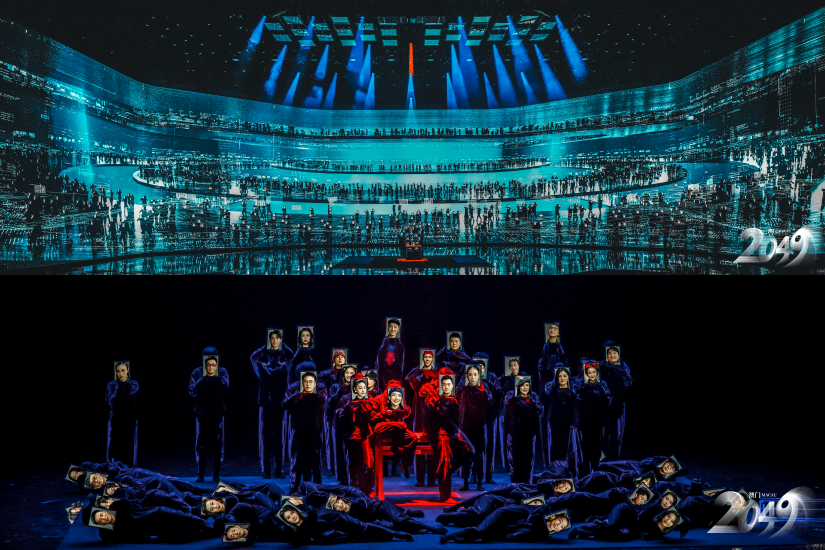
The Peking Opera “Sancha Kou” is a classic martial arts play, inspired by the “Tales of the Yang Family,” and first appeared in the vernacular dramas of the Ming Dynasty. The story takes place during the Song Dynasty on a night when Ren Tanghui, under the orders of Yang Yanzhao, secretly protects General Jiao Zan at the Sancha Kou. While staying overnight at an inn, the innkeeper Liu Lihua mistakenly believes that Ren Tanghui is an enemy while trying to save Jiao Zan. This leads to a fierce fight in the dark, but they ultimately resolve their misunderstanding and shake hands in reconciliation. The performers must coordinate perfectly in the darkness, showcasing exceptional martial arts skills and physical coordination; to portray the dark environment, the stage design is minimalistic, strictly controlling lighting to give viewers an immersive experience.
As the scene shifts, we enter the era of the Internet. With the ubiquity of smart technology, social software has become an important platform for daily communication. It offers not only instant messaging, voice, and video calling features, but also more mature and convenient applications of AI technology, such as intelligent recommendations, automatic replies, and voice recognition. Beneath the “masks” of electronic devices, people’s interactions seem to have returned to that night of anonymity where faces are no longer seen.
5. Intangible Cultural Heritage of China X Technology Focus: 《Yangge · CNC
Yangge X Robot Performance
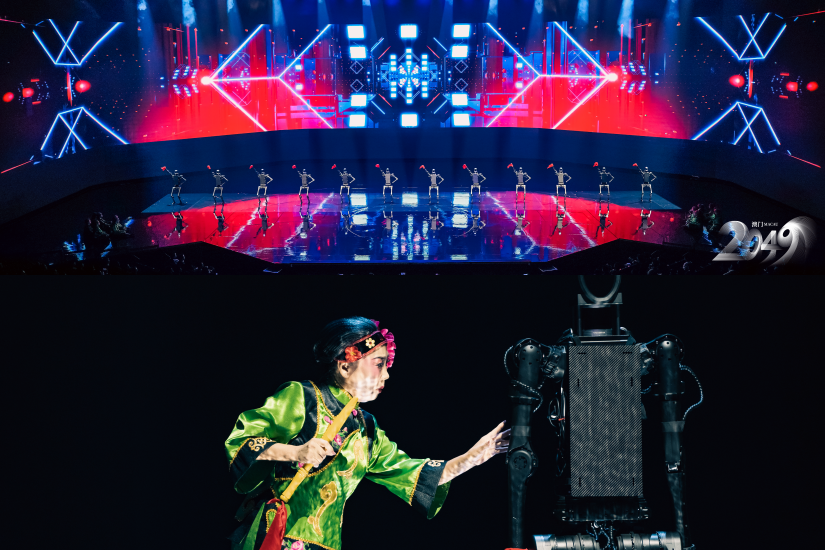
Yangge is a widely popular folk dance in northern China, characterized by its strong community involvement. It is divided into “stilt yangge,” which involves the use of stilts, and “ground yangge,” which does not. The ground yangge from Changli, Hebei, is a typical representative of this tradition, having originated in the Yuan Dynasty. Through unrestricted movements of hands and feet, people express their hopes for good weather and abundant harvests, gathering love for life and pure joy from the land and the bustling farming activities. It is vibrant, exuberant, optimistic, and humorous. Notably, the role of the “matchmaker” in yangge performances is significant. The matchmaker serves not only as a facilitator of marriages but also as a mediator for family disputes, deeply reflecting the local social life and traditional culture’s emphasis on marriage and family relationships.
The humanoid robot H1, produced by Yuzhu Technology, is a full-sized electric humanoid robot that has set a world record for humanoid robot motion speed, achieving a mobility speed of 3.3 m/s and a peak joint torque of 360 Nm. It can perform various movements such as walking, running, and jumping quickly and stably. Additionally, it integrates the world’s most powerful power system and AI system, boasting sensitive perception capabilities, enabling autonomous navigation, and further learning to optimize its behavior patterns and decision-making logic, making it the strongest robot of its kind in the world today.
6. Intangible Cultural Heritage of China X Technology Focus: 《Yi Voice · Ocean》
Yi Voice X Biomimetic Drone Performance

“Yisheng” refers to a collection of various songs popular in the Honghe Hani and Yi Autonomous Prefecture in Yunnan Province, China, specifically the love songs sung by young men and women of the Nisu people during gatherings. The structure of the songs is complex and expansive, featuring a unique singing style that has been hailed as the “beautiful voice” technique within the ethnic community, characterized by a wide vocal range, passionate and melodious tones, reminiscent of the clear and bright Yilong Lake stirring up waves. During performances, singers typically wear traditional Yi attire and are accompanied by traditional instruments such as the four-stringed instrument, mouth harp, and leaves. The performance included four pieces: “Chuxiong Wine Song,” “Mountain Melody,” “Crying Bride,” and “Flower Waist Yi Longing Tune,” each expressing heartfelt emotions such as the joy of reunion, the happiness of gathering, and the sorrow of parting.
Accompanied by models of bionic flying devices floating in the space, resembling sea turtles and fish, it immerses people in a marine world while telling stories about the beauty of nature and pollution-related disasters, allowing for an immersive experience of the importance of nature. The bionic flying devices are developed by Airstage, aimed at creating new technologies and solutions through biomimicry, such as imitating the flight of birds and insects, developing lightweight structures and energy-efficient flight technologies, as well as autonomous flight and group coordination technologies. The bionic technology project not only represents cutting-edge exploration in technological innovation but also demonstrates how humanity draws inspiration and wisdom from nature, propelling the development of industrial automation technology.
7. Intangible Cultural Heritage of China X Technology Focus: 《Beautiful Lion · Radiance》
Lion Dance X CNC Lion Sculpture
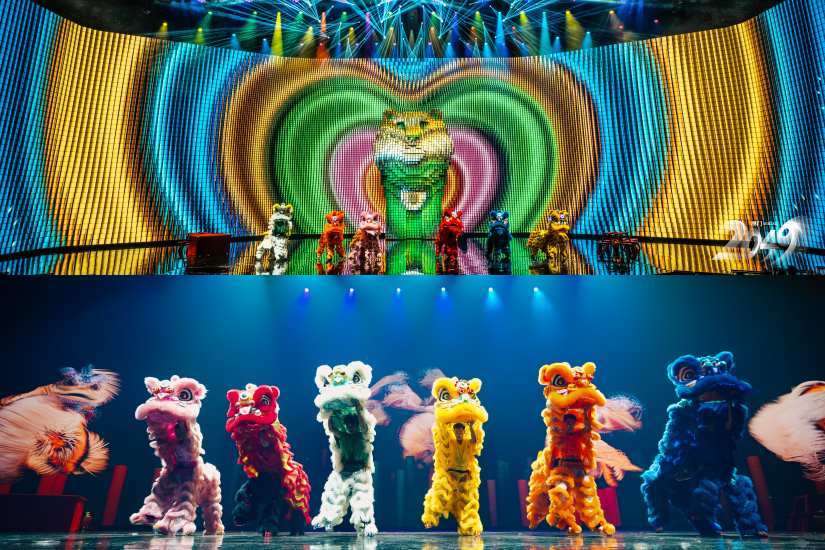
Lion dance combines martial arts, dance, performance, and music, embodying a collective art form that vividly mimics the movements and expressions of a lion. It requires not only good physical strength, endurance, and balancing skills, but also the perfect coordination between the lion’s head and tail. Meanwhile, the musicians act as both conductors and the soul of the dance. In China, the lion dance is seen as a auspicious symbol for driving away evil spirits, avoiding disasters, and attracting wealth. It represents national pride and the spirit of China; wherever there are Chinese communities, there is bound to be lion dance.
The lion dance performance on the large screen is captured through dynamic imaging, consisting of four modules: a high-speed capturing system, a device synchronization system, a virtual shooting system, and a data management system. The lion’s CNC sculpture is made up of 2,118 gold bricks, constructed as a CNC matrix device based on the principles of linear algebra and numerical computation. This involves mathematical concepts such as matrix multiplication, inverse operations, and eigenvalue decomposition, and realizes rotational movement through control system applications and data programming. The complex motion path, combined with stunning light and shadow effects, creates an array of captivating dynamics, while the golden reflective texture enhances the sensory experience. Behind it, the large screen is also programmed to sequentially flip 49,404 identical gold brick pixels on a 4K resolution display, creating a rich and vibrant visual effect.
8. Chinese Intangible Cultural Heritage X Technology Focus: 《Storytelling · Origins》
Shanbei Storytelling X Laser Performance
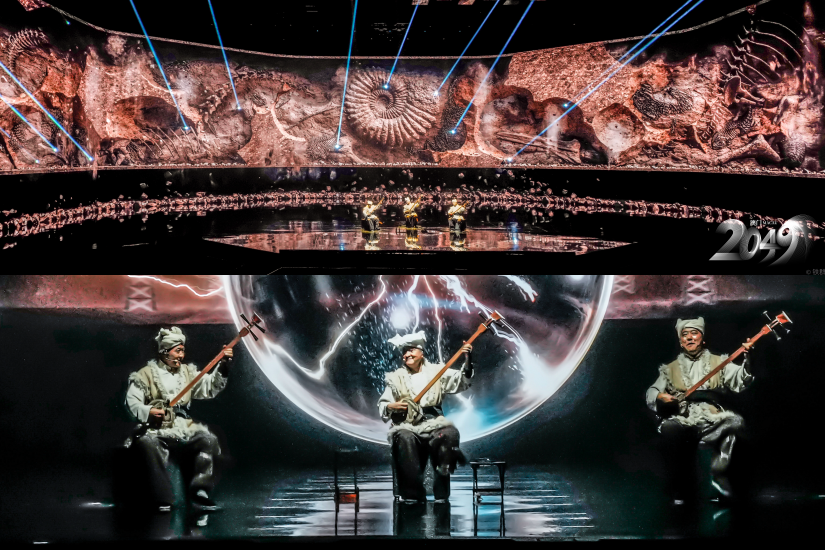
The storytelling tradition of Shanbei originated during the Ming and Qing dynasties and is an ancient folk performance art from the northern part of Shaanxi, China. Storytellers embrace a sanxian (a three-stringed instrument), tie their legs with a wooden board, and bind their hands with tiles, performing with vivid expression and animated speech. From legendary tales and historical events to the everyday scenes of life, the three strings of the sanxian and a beautifully embroidered mouthpiece bring to life countless stories from the past; the singing style is melodious and varied, capable of both gentle murmurs and high-spirited exclamations, aptly known as the “Ninety-Tone Eighteen Melodies.” In Shanbei storytelling, there are no tragedies, reflecting the optimistic, bold, and indomitable spirit of Shanbei farmers, embodying a heroic disposition and idealism.
Seven 34-watt full-color laser lights were used for the performance, with each light emitting 10 beams, creating a total of 70 sets of beams on stage simultaneously. The laser lights consist of lasers, scanners, controllers, and fog machines. The precision of the lasers relies on the efficient integration of optical technology and programming control systems. Through programming, the controller synchronizes with the rhythm of the music to issue commands, adjusting the color, brightness, direction, and motion trajectory of the lasers, painting precise points, lines, and surfaces at a rate of 50 frames per second, delivering an astonishing visual experience.
Additional Screening 1:
Dynamic Art Installation “The Lion Turns” in Mechanical Matrix

Production Team: Boin High-Tech (Beijing) Co., Ltd.
Installation Dimensions: H3500 x W2535 x D2958mm
CREDIT: MGM
The prototype of the device originates from director Zhang Yimou’s first residency performance in Macau, titled “Macau 2049.” It has been designed and refined over the course of a year. The design of the majestic lion incorporates cultural elements from ancient Chinese jade, ancient Egyptian sculptures, and pixel aesthetics, blending both ancient and modern influences. Constructed using 3,988 gold bricks, it achieves dynamic transformations through the application of control systems and data programming to realize a sequential matrix physical flip.
Limited-time special feature:
“Zhang Yimou Director’s Studio──Discovering the Special Exhibition of ‘Macau 2049‘”
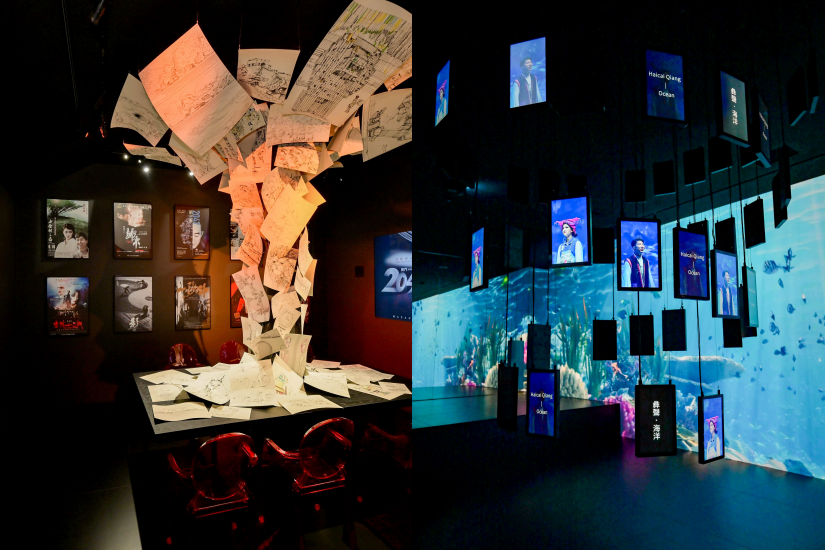
As a special exhibition spun off from “Macau 2049,” its curatorial theme revolves around the concept of “Harmony.” It immerses visitors in captivating snippets of performances and also features an interactive installation based on one of the scenes. Additionally, it recreates the workspace of director Zhang Yimou, allowing the public to explore design sketches and creative insights from “Macau 2049,” offering a deeper understanding of how the director brings together global creative talents and weaves captivating stories through a multi-dimensional artistic lens.
《Macau 2049》
Date: Starting from December 15, 2024 (Closed on Mondays and Tuesdays)
Time: 19:00 – 20:20
Location: Macau | MGM Theater
Ticket Price: MOP 288 | 488 | 688 | 888 (Free for children under 3, not suitable for children under 13)
Official Website: https://macau2049.mgm.mo/tc/
Dynamic Artistic Installation “The Lion Comes to Life”
Location: MGM Grand, Grand Lion Lobby
The Zhang Yimou Director’s Studio ── Behind the Scenes of “Macau 2049” Special Exhibition
Date: Now until February 16, 2025
Time: Monday to Friday (12:00 – 19:00) | Saturday, Sunday and Public Holidays (12:00 – 21:00)
Location: Macau | Maritime Workshop No. 2
(Free Admission)

